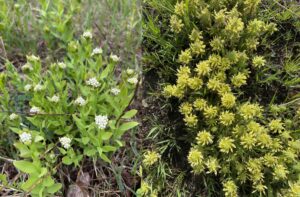By Max Kornetzke, land manager
 Early spring often evokes the imagery of showy flowers. Many are delighted after winter to see the native plants like trilliums, spring beauties, or bloodroot; or, for many Americans, ornamentals such as daffodils, crocus, and tulips. But spring is also a time for some unique flowering plants to offer their unusual beauty.
Early spring often evokes the imagery of showy flowers. Many are delighted after winter to see the native plants like trilliums, spring beauties, or bloodroot; or, for many Americans, ornamentals such as daffodils, crocus, and tulips. But spring is also a time for some unique flowering plants to offer their unusual beauty.
Bastard Toadflax (Comandra umbellata) and Wood Betony (Pedicularis canadensis) are two hemi-parasitic plants that bloom in mid-April to early May. Hemi-parasites are plants that are partially parasitic; they have specialized root structures called haustoria that attach to the host plant’s roots in order to siphon nutrients, but they also still receive energy from photosynthesis. Because they photosynthesize, they produce chlorophyll, which gives them green leaves, unlike true parasites, which have evolved to receive all of their energy from their hosts and may have white (Monotropa uniflora), red (Corallorhiza species), yellow (Conopholis americana) even orange (Cuscuta species) coloration.
Though these two plants are not closely related, they’re both often found in the same habitat of dry, well- draining soils at the edge of or in open woodlands and prairies. As they push out their fresh leaves, they both often have reddish to purple pigmentation, a common adaptation for plants that protects their young leaves from the sun’s radiation.
Bastard toadflax’s common name comes from its elliptic leaves alternating up the stem resembling that of various species of toadflax. The white flowers form in clusters at the ends of the stem and upper leaf axils. If you find one, you will find many of this plant as they spread to form colonies via their rhizomatic root systems. It is also very generalist with what genera of plants it will latch its haustoria onto, including: maples, birches, oaks, roses, asters, sedges, and grasses.
Wood Betony’s leaves are very striking. They have many deeply cut, toothed, rounded lobes that have downy hairs and an overall wrinkly look. The initial growth is a small rosette, and as they send up their flowering stock smaller leaves spiral around the stem. The flower structure is just as interesting as the leaves. Yellow tubes poke out, spiraling around the inflorescence (flower head). These tubes are relatively long and attract pollinators with long tongues such as various bumblebees, butterflies, and skippers. The host plants for Wood Betony include asters and native grasses.
Make sure to keep your eyes on the ground this spring in search of the curious patterns created by these intriguing hemi-parasites.
Photo split: left care of Max Kornetzke, right care of inaturalist (c) Brandon Corder.
